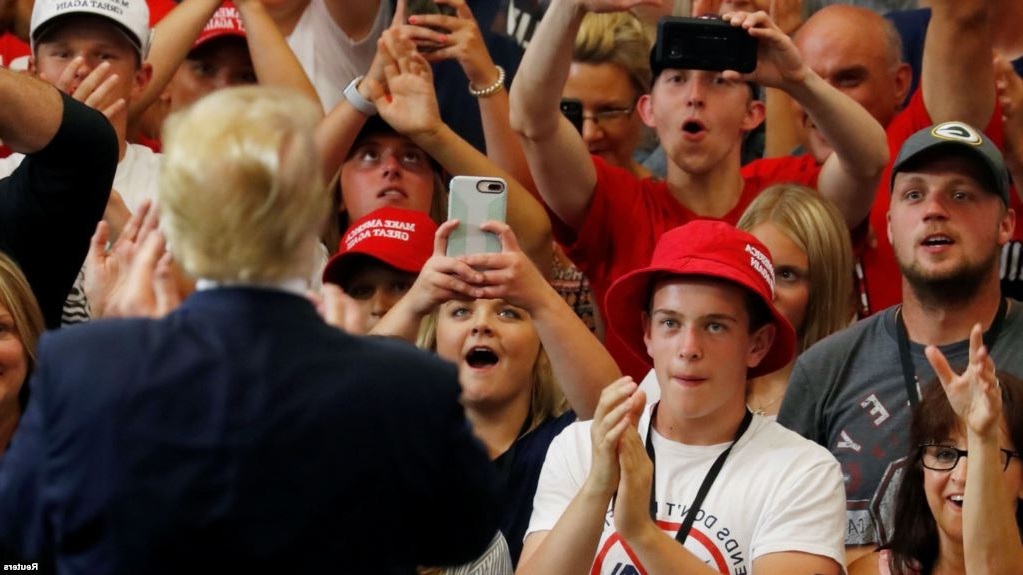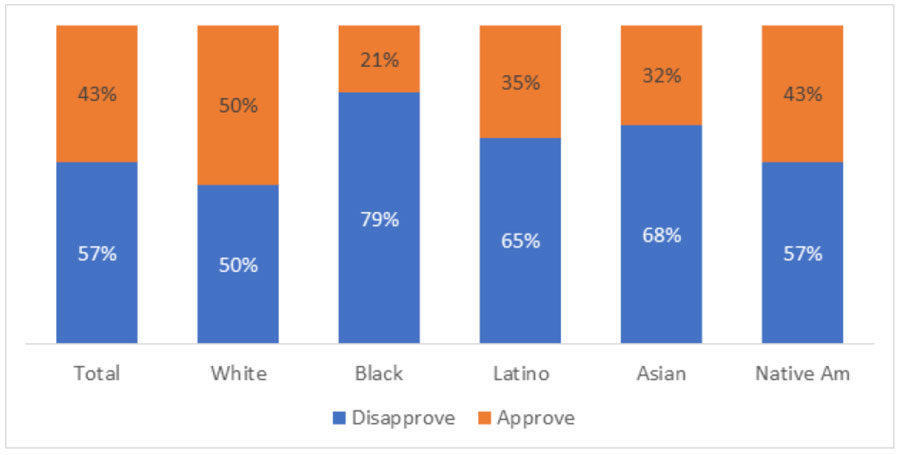Previous articles about why populism is dangerous have addressed the issue of austerity (here), the public health crisis (here), the false “migrant crisis” (here), and the propensity for war (here). This article explores Trump’s midterms strategy to drive voters to the ballot on November 6: stoking up fear and anger with fabricated crises and false solutions.
The 6 November midterm elections are seen by many as a referendum on how American citizens are ranking Trump’s performance as President. Democrats are favored to win the House and Republicans the Senate.
Surprisingly, even though the economic news are favorable, with 55% of Americans rating current economic conditions as excellent or good, the political climate is not correspondingly as good for Republicans and Trump, the latest Gallup poll shows.
Congress’ 21% job approval rating is 10 points below the average since 1974 and similar to approval ratings in the 2010 and 2014 midterms. Trump’s approval rating at 40% is well below the 52% average at midterms since 1974 and is one of the lowest ever for a president prior to a midterm election.
With such results, it is not surprising that Trump has pulled all the populist stops at his disposal: fake news, fabricated crises, false solutions. All designed to fuel emotions, stoking fear and anger to push voters to the polls. Even famous memes are used, like the Stark family motto of HBO’s Game of Thrones “Winter is coming”, to announce the reimposition of sanctions on Iran. They will take effect on Monday 5 November, the day before the elections. To make sure everyone would notice, Trump exceptionally took the trouble of pinning the tweet at the top of his thread:
— Donald J. Trump (@realDonaldTrump) November 2, 2018
This caused a storm on Twitter and HBO did not appreciate the use of its intellectual property for political purposes.
No matter that this stokes divisions. That the country is increasingly polarized. That people die while praying in a synagogue. That the public postal system is used to send pipe bombs. For Trump, it’s collateral damage of little import. The point is to win.
This is the populist strategy for maximum voter turnout: as a populist, you may hold a minority of the voters but your hold on them is stronger because they are emotionally pumped up. It’s not a question of pushing the “undecided vote” as analysts have traditionally called it; it’s a question of pushing those who already support you to actually go to the voting booths. You don’t need to convince them (that’s done). What you need to do is fire them up so that they will make the effort to vote.
Trump’s Fear and Anger Strategy
Trump is in campaign combat mode. The language on race and gender is strident, the anti-immigrant message oppressive. He twists the facts on immigration with a speech on immigration that is laden with falsehoods. Fear the “caravans” of migrants out of Honduras but rest assured, Trump will save you. He will send troops to the border; he will build “tent cities” to stop the migrants from spreading in the country; he will end birthright citizenship that he claims is a magnet for migrants (no matter that over 30 other countries have them).
The objective: shift public attention from recent public safety crises, the pipe bombs in the mail and the synagogue massacre. The video he posted on Twitter encapsulates his strategy:
It is outrageous what the Democrats are doing to our Country. Vote Republican now! https://t.co/0pWiwCHGbh pic.twitter.com/2crea9HF7G
— Donald J. Trump (@realDonaldTrump) October 31, 2018
Luis Bracamontes, the man in the video, is an illegal immigrant twice previously deported, who in 2014 shot and killed two California police officers, and injured a third. The video shows Bracamontes, who has been sentenced to death, laughing in court and vowing to kill more officers. He is obviously not your “average” immigrant.
Forget that posting such a video is stunningly unpresidential and that the advert is clearly tendential and racist. Trump posted this video for his fans, not for the rest of the country, the 56% who disapprove of him. Update 6 November: Following the uproar, the ad was pulled by Fox News, NBC and Facebook.
Trump ramps up his rhetoric daily: first he promises to send 5200 troops to defend the southern border; next, he’ll send up to 15,000 troops; finally he gives them a free ticket to respond disproportionately to threats: The military can shoot if rocks are thrown at them, he says “consider it a rifle”. He later reversed himself saying they won’t shoot, but the objective (draw attention, occupy public debate) is in any case reached.
And now there are last minute premium adds-on: a special tax break for the middle class (to assuage the anger of people who felt left out of the tax cut); cutting a new deal with China (to stoke hopes a trade war will be avoided). Clever but not cutting the ice: On Friday, the S&P 500 dropped and Nasdaq stocks slid.
This was a winning strategy in 2016. Is it still so in 2018?
Midterms compared to 2016 presidential election
The following emerging factors could affect the election results for Trump:
(1) A Generational and Gender Shift
Republican allegiances among higher-end suburban whites who normally vote Republican are shifting and this could counterbalance the pro-Trump votes of disenfranchised working whites. In particular, wealthy, college-educated women are turned off by Trump’s divisive language on gender and sex.
(2) New Faces in the Democratic Party
The party has launched an exceptionally large number of new, untried politicians, especially women. This could be a game changer. In 2016, people voted against Hillary Clinton because she was too “establishment”. People wanted change, especially Millennials. That’s why they had voted Bernie Sanders and his new form of progressive politics. If Clinton had understood this and taken Sanders as her co-runner, no doubt she could have won the presidency.
(3) A Fundamental Shift in the Democratic Political Message
The shift hinges on two factors: (1) New political faces that are fully integrated with their constituency and do not appear “elite” in any way; (2) an incendiary political message.
Watch how Richard Ojeda, a retired army major and a Democrat, does it. He is running in an overwhelmingly pro-Trump coal district in West Virginia and he is truly “part of the people”, born there, raised there, speaking like them:
His message is stunningly simple: “When we get to the point where all we have is the filthy rich and the dirt poor, the dirt poor will eat the filthy rich”. And it is striking to see how both candidates are in fact backed by billionaires, Ojeda by Silicon Valley (he hopes to bring new tech jobs to the district) and the Republican one with $750 000 from a Trump Pac setup, part of the many $ millions more he got compared to Ojeda.
Note what is at the heart of the Democratic message. They, and Ojada among them, are all saying: “Here is what matters to us and here’s what we’re doing.’” None of them gives into Trump bashing, they actually “tiptoe” around the President. Unless it is of course too devastating – like his lack of presidential reaction to the pipe bombs and the synagogue massacre.
That violence is real, his talk about caravans is fake and that difference is sinking in with voters. Bottom line, voters aren’t stupid. You can fool them some of the time but not all the time.
(4) People of Color
The NAACP survey in August proved that racism would be a big issue in the midterms. A small bump in popular support for Trump among African-Americans was reported, a fact gleefully picked up by the conservative media. But that bump is irrelevant if you consider the actual numbers. They show:
- An extremely low level of support, much lower than whites for all voters of color. Trump’s approval numbers are clearly underwater and for no racial/ethnic group of voters surveyed does he have majority approval:
- An astonishingly high level of Trump rejection by African-American women: When asked whether Trump has ever made them feel ‘disrespected,’ fully 89% of the African American women surveyed said ‘YES.’ No other group was close to this percentage. That would give them a big motive to go out and vote.
But voting may turn out to be difficult for people of color. Republicans are reported to be seeking every possible way to obstruct them. For example, NAACP lawyers in Texas are accusing Republicans of rigging voting machines in favor of their candidate Ted Cruz at the expense of Beto O’Rourke; in Georgia, they are holding up thousands of voter registration forms (some 53,000).
The examples can be endlessly multiplied and at this point in time it is hard to evaluate to what extent election results will be affected.
The Midterms: A Crucial test for Trump and Populism Worldwide
One thing is certain. Just before the elections, Trump’s approval rating has dropped four points and now stands at 40% . This may be a signal of worse to come. After all, at the same time into their presidency just before the midterms, Obama’s approval rating stood at 45% (Nov. 2010) and George Bush at 66% (Nov. 2002).
What is most likely is that Trump’s approval rating is settling down to the hard core of his base, his term average to date of 39%. That is considerably below the 1938-2018 average for U.S. Presidents which is 53 percent.
In short, Trump, contrary to what he would like to believe, is not a popular president. He is perhaps the least popular President in U.S.History. But those who vote for him will vote no matter what. They may be a minority but it’s a hurdle that is easily overcome by their enthusiasm for Trump. That’s a key factor in Trump’s success, and it goes a long way to explain why Trump keeps banging the same old drums.











